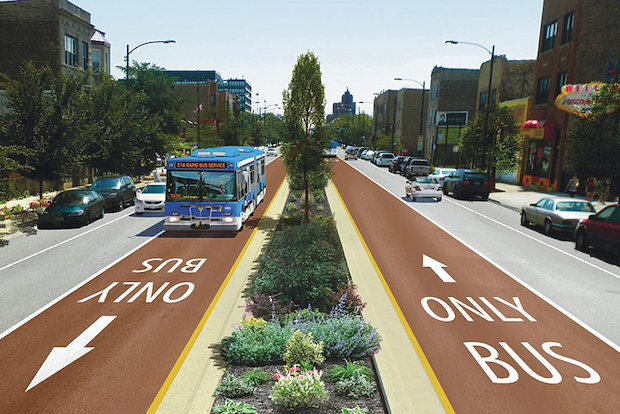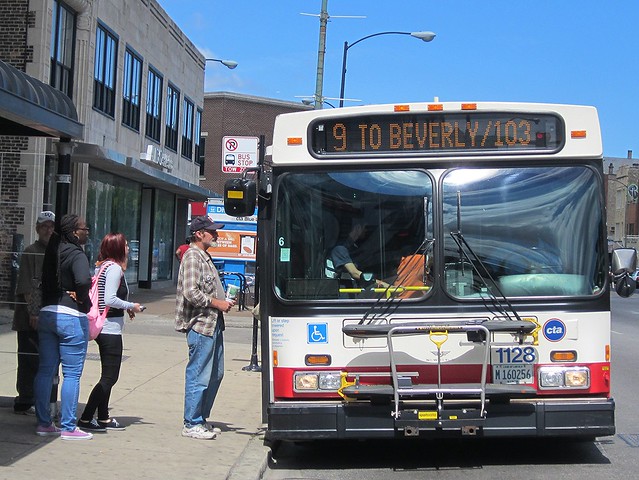The city of Chicago has been pretty quiet on the subject of its Ashland bus rapid transit plan lately, but recently there have been encouraging signs that even some skeptics are warming to the concept.
During a presentation about the project to the Wicker Park Committee neighborhood group last week, WPC member Alan O’Connell, an urban planner who works at a shipping logistics company, encouraged BRT doubters to work with the city to improve the plan rather than fight it, DNAinfo reported. The committee had previously voted against the plan, which would nearly double bus speeds on Ashland between 95th and Irving Park by converting two out of four travel lanes to dedicated bus lanes, building ‘L’-style median stations, and adding various other time-saving features.
"This isn't something you should all be scared of," said O'Connell, a Cleveland native who has witnessed the success of that city’s Health Line. "It's really good when done right."
Some Chicago residents have opposed the Ashland plan on the grounds that the lane conversions will create gridlock – the CTA predicts car speeds will be reduced by only ten percent – and that the prohibition of most left turns off of Ashland will drive traffic onto side streets. In reality, it will be fairly simple for drivers to plan routes that don’t require lefts off the street.
Not all attendees were persuaded by O’Connell’s words. "It will destroy our community totally," said Mitchell Hutton, a Wicker Park resident. Hutton worried that pedestrians could be struck by cars as they cross to the median stations. Commenters on the DNA piece pointed out that people are already crossing Ashland to access bus stops on the opposite side of the street, and the BRT stations will improve pedestrian safety by doubling as refuge islands.
O’Connell said the city should fine-tune the plan, to make it more acceptable to residents. Allowing more left turns at main intersections is a possibility, although this would delay the BRT buses and other through traffic. He added that the city should come up with strategies, such as traffic calming, to keep vehicles off residential streets. And while the Ashland plan currently calls for retaining curbside local bus service, he argued the CTA should discontinue it, so that it doesn’t cannibalize BRT ridership.
After hearing O’Connell’s presentation, WPC president Leah Root said she now believes it might make sense for the group to work with the city on a compromise, rather than simply opposing the plan. O’Connell hopes to get more community groups to provide constructive input on the plan, instead of fighting it.
On Monday, the nearby East Village Association community group also voted against Ashland BRT, but by a razor-thin margin of eleven to nine, DNA reported. Furthermore, much of the opposition was due to concerns about additional traffic on side streets, which could be addressed with traffic calming.
“As a guy who lives on Winchester, that lives in a 120-year-old house, and I’ve got two kids on the street, and I’ve already got a street that’s filled with vehicles," said EVA president Neal McKnight. However, member Robert Schnickel, who said he originally was against BRT, pointed out that speed humps, traffic circles, and conversion of some streets to one-ways, could help prevent excessive traffic volume and speeding on side streets. In order to reassure residents, the city should commit to installing traffic calming where needed.
Other attendees lauded the many potential benefits of the plan, noting that the $160 million BRT system would be a fraction of the cost of adding a new rail line, and that faster buses will provide better access to job centers like the Illinois Medical District. McKnight said that if the city alters the plan to address members’ concerns, the group might take another vote on the issue in the future.
City Notes blogger and Streetsblog contributor Daniel Hertz argued yesterday that the EVA deciding against BRT by a mere two votes represents a kind of backhanded endorsement:
So the neighborhood from which the most vitriolic opposition to Ashland BRT has come had its formal vote, and only opposed the project by the narrowest margin possible. Moreover, only eleven people actually cared enough to come out and actually vote against it. Eleven people. The idea that there is a huge groundswell of strong opposition to BRT was dealt a really serious blow here.
It's good to hear that even some of those who have been opposed to BRT are discussing the possibility of supporting it, if the city is willing to work with them to address issues like left turns and traffic diversion. It appears that the plan is gaining momentum.





